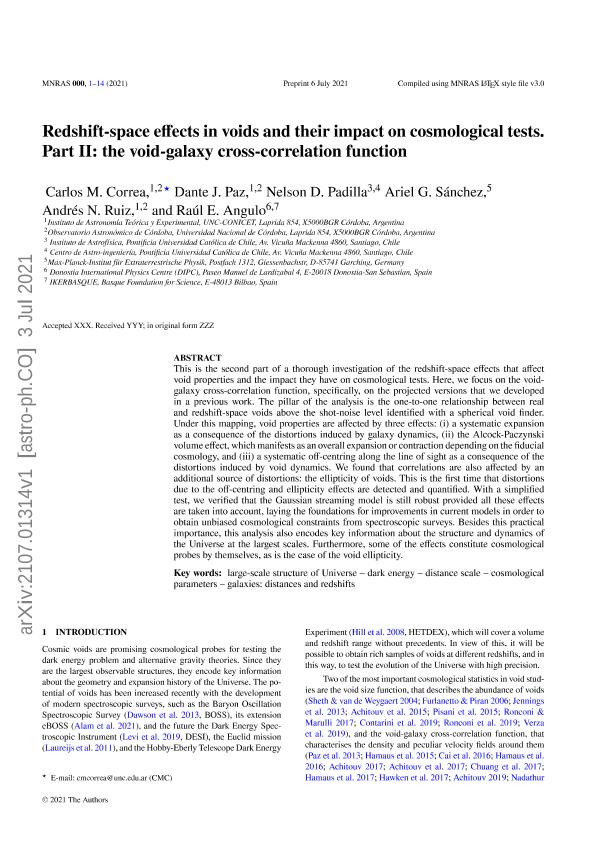Mostrar el registro sencillo del ítem
dc.contributor.author
Correa, Carlos Mauricio

dc.contributor.author
Paz, Dante Javier

dc.contributor.author
Padilla, Nelson David

dc.contributor.author
Sanchez, Ariel Guillermo

dc.contributor.author
Ruiz, Andrés Nicolás

dc.contributor.author
Angulo, Raúl E.
dc.date.available
2023-07-07T16:57:37Z
dc.date.issued
2022-01
dc.identifier.citation
Correa, Carlos Mauricio; Paz, Dante Javier; Padilla, Nelson David; Sanchez, Ariel Guillermo; Ruiz, Andrés Nicolás; et al.; Redshift-space effects in voids and their impact on cosmological tests – II. The void-galaxy cross-correlation function; Wiley Blackwell Publishing, Inc; Monthly Notices of the Royal Astronomical Society; 509; 2; 1-2022; 1871-1884
dc.identifier.issn
0035-8711
dc.identifier.uri
http://hdl.handle.net/11336/202728
dc.description.abstract
This is the second part of a thorough investigation of the redshift-space effects that affect void properties and the impact they have on cosmological tests.Here, we focus on the void-galaxy cross-correlation function, specifically, on the projected versions that we developed in a previous work.The pillar of the analysis is the one-to-one relationship between real and redshift-space voids above the shot-noise level identified with a spherical void finder.Under this mapping, void properties are affected by three effects: (i) a systematic expansion as a consequence of the distortions induced by galaxy dynamics, (ii) the Alcock-Paczynski volume effect, which manifests as an overall expansion or contraction depending on the fiducial cosmology, and (iii) a systematic off-centring along the line of sight as a consequence of the distortions induced by void dynamics.We found that correlations are also affected by an additional source of distortions: the ellipticity of voids.This is the first time that distortions due to the off-centring and ellipticity effects are detected and quantified.With a simplified test, we verified that the Gaussian streaming model is still robust provided all these effects are taken into account, laying the foundations for improvements in current models in order to obtain unbiased cosmological constraints from spectroscopic surveys.Besides this practical importance, this analysis also encodes key information about the structure and dynamics of the Universe at the largest scales.Furthermore, some of the effects constitute cosmological probes by themselves, as is the case of the void ellipticity.
dc.format
application/pdf
dc.language.iso
eng
dc.publisher
Wiley Blackwell Publishing, Inc

dc.rights
info:eu-repo/semantics/openAccess
dc.rights.uri
https://creativecommons.org/licenses/by-nc-sa/2.5/ar/
dc.subject
LARGE-SCALE STRUCTURE OF UNIVERSE
dc.subject
DARK ENERGY
dc.subject
DISTANCE SCALE
dc.subject
COSMOLOGICAL PARAMETERS
dc.subject
GLAXIES:DISTANCES AND REDSHIFTS
dc.subject.classification
Astronomía

dc.subject.classification
Ciencias Físicas

dc.subject.classification
CIENCIAS NATURALES Y EXACTAS

dc.title
Redshift-space effects in voids and their impact on cosmological tests – II. The void-galaxy cross-correlation function
dc.type
info:eu-repo/semantics/article
dc.type
info:ar-repo/semantics/artículo
dc.type
info:eu-repo/semantics/publishedVersion
dc.date.updated
2023-07-06T11:19:27Z
dc.identifier.eissn
1365-2966
dc.journal.volume
509
dc.journal.number
2
dc.journal.pagination
1871-1884
dc.journal.pais
Reino Unido

dc.journal.ciudad
Londres
dc.description.fil
Fil: Correa, Carlos Mauricio. Consejo Nacional de Investigaciones Científicas y Técnicas. Centro Científico Tecnológico Conicet - Córdoba. Instituto de Astronomía Teórica y Experimental. Universidad Nacional de Córdoba. Observatorio Astronómico de Córdoba. Instituto de Astronomía Teórica y Experimental; Argentina. Universidad Nacional de Córdoba. Observatorio Astronómico de Córdoba; Argentina
dc.description.fil
Fil: Paz, Dante Javier. Consejo Nacional de Investigaciones Científicas y Técnicas. Centro Científico Tecnológico Conicet - Córdoba. Instituto de Astronomía Teórica y Experimental. Universidad Nacional de Córdoba. Observatorio Astronómico de Córdoba. Instituto de Astronomía Teórica y Experimental; Argentina. Universidad Nacional de Córdoba. Observatorio Astronómico de Córdoba; Argentina
dc.description.fil
Fil: Padilla, Nelson David. Pontificia Universidad Católica de Chile; Chile. Consejo Nacional de Investigaciones Científicas y Técnicas. Centro Científico Tecnológico Conicet - Córdoba. Instituto de Astronomía Teórica y Experimental. Universidad Nacional de Córdoba. Observatorio Astronómico de Córdoba. Instituto de Astronomía Teórica y Experimental; Argentina
dc.description.fil
Fil: Sanchez, Ariel Guillermo. Consejo Nacional de Investigaciones Científicas y Técnicas. Centro Científico Tecnológico Conicet - Córdoba. Instituto de Astronomía Teórica y Experimental. Universidad Nacional de Córdoba. Observatorio Astronómico de Córdoba. Instituto de Astronomía Teórica y Experimental; Argentina. Pontificia Universidad Católica de Chile; Chile. Institut Max Planck Fuer Gesellschaft. Max Planck Institute For Extraterrestrial Physics.; Alemania
dc.description.fil
Fil: Ruiz, Andrés Nicolás. Consejo Nacional de Investigaciones Científicas y Técnicas. Centro Científico Tecnológico Conicet - Córdoba. Instituto de Astronomía Teórica y Experimental. Universidad Nacional de Córdoba. Observatorio Astronómico de Córdoba. Instituto de Astronomía Teórica y Experimental; Argentina
dc.description.fil
Fil: Angulo, Raúl E.. Donostia International Physics Centre; España. Basque Foundation for Science; España
dc.journal.title
Monthly Notices of the Royal Astronomical Society

dc.relation.alternativeid
info:eu-repo/semantics/altIdentifier/url/https://academic.oup.com/mnras/article/509/2/1871/6409144
dc.relation.alternativeid
info:eu-repo/semantics/altIdentifier/arxiv/https://arxiv.org/abs/2107.01314
dc.relation.alternativeid
info:eu-repo/semantics/altIdentifier/doi/https://doi.org/10.1093/mnras/stab3070
Archivos asociados
